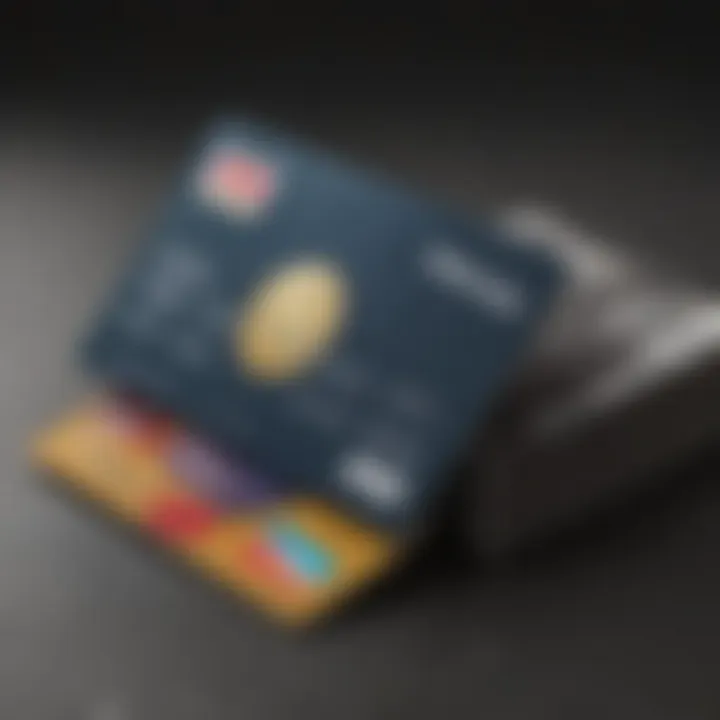Understanding Pay As You Go Credit Cards


Intro
In today’s financial landscape, pay as you go credit cards are gaining attention. With their unique structure, these cards serve as a flexible alternative to traditional credit cards. They allow users to manage their spending more effectively while also minimizing the risks associated with debt accumulation. This article aims to thoroughly explore the nuances of pay as you go credit cards, offering insights into their features, applications, and comparative advantages over conventional cards.
Overview of Financial Product
Definition
A pay as you go credit card is a type of prepaid card that requires users to load an amount of money onto the card before making purchases. Unlike typical credit cards, which extend a line of credit to the user, these cards operate on a simple principle: spend only what you load. This model appeals to various consumer profiles, including those looking for better budgeting tools or individuals with less established credit.
Key Features
Pay as you go credit cards have distinct characteristics:
- Prepaid System: Users must deposit funds to use the card, ensuring no debt option.
- Control Over Spending: They help in monitoring expenses since users can only spend what is available on the card.
- Limited Fees: Many pay as you go cards come with fewer fees compared to traditional credit cards.
Purpose and Benefits
The primary purpose of pay as you go credit cards is to provide users with a manageable option for transactions without the complexities of credit limits or interest rates. The benefits are clear:
- Enhanced control over spending habits.
- A useful tool for budgeting, especially for students and families.
- Opportunity to build credit history when reported to credit bureaus.
Pay as you go credit cards can serve as a bridge for those seeking to improve their financial literacy and practices without the risks associated with traditional credit lines.
Types and Categories
Credit Card Types
Pay as you go credit cards come in various forms. They exist as general-purpose cards usable in many retail settings or as niche cards tailored for specific purchases, such as travel or dining.
Pros and Cons
Pros:
- Budget Friendly: Users can track their spending closely.
- No Interest Rates: Since it is a prepaid system, there are no annual percentage rates (APR).
Cons:
- Limited Acceptance: Not all merchants may accept prepaid options.
- Potential Fees: While many offer free use, some require maintenance fees or withdrawal fees.
Situational Uses
These cards can be particularly beneficial in scenarios like:
- Traveling to manage foreign currency expenditures.
- Using as a budgeting tool during holidays or special occasions.
- Introducing students to the concepts of financial management without the risk of credit accumulation.
Application Process
Steps to Apply
Applying for a pay as you go credit card is generally straightforward. The steps include:
- Research Options: Compare various offerings in terms of fees and features.
- Submit Application: Fill in personal details and load an initial amount.
- Receive Card: Activate it upon receipt, ready for use.
Eligibility Requirements
Typically, eligibility is minimal, as these cards do not involve credit checks. Users must be of a certain age, usually at least 18 years old.
Documentation Needed
Documentation can vary by issuer but often includes:
- A valid identification document.
- Proof of address (like a utility bill).
- Initial funding amount.
Common Mistakes to Avoid
Avoid these pitfalls when applying:
- Not reading the fine print for fees.
- Miscalculating loading amounts, leading to inconvenience.
Tips for Success
For effective use:
- Regularly review your balance and spending history.
- Load the card strategically to avoid excess in fees.
Costs and Fees
Types of Fees Associated
While many pay as you go cards boast minimal fees, users should be aware of possible charges:
- Activation Fees: Some cards may charge a one-time fee.
- Reload Fees: Costs incurred when adding money to the card.


Comparisons of Costs Across Options
It is beneficial to compare these fees to conventional credit cards. Traditional cards often carry significant interest charges, while pay as you go cards may only require an initial activation fee, making them a more budget-friendly option in many instances.
Consider your financial habits and choose wisely.
Prolusion to Pay As You Go Credit Cards
Pay As You Go credit cards have gained attention in recent times due to their unique structure and functionality. Understanding these cards is essential for anyone looking to manage their finances effectively. They offer a distinct approach to credit, prioritizing spending within means while providing flexible options for users. This article aims to explore the core elements, benefits, and considerations associated with Pay As You Go credit cards.
Definition and Characteristics
Pay As You Go credit cards are designed to provide a controlled payment method, allowing users to only spend what they have prepaid. This model starkly contrasts with traditional credit cards, where one borrows money up to a certain limit. The primary characteristics of these cards include:
- Pre-funded amounts: Users load money onto the card before making purchases.
- Limited credit risk: Since spending is capped by the prepaid balance, users avoid the risk of accumulating debt.
- Accessibility: They are often easier to obtain for individuals with limited or poor credit history.
- Flexibility in spending: Users can choose how much to load and when to spend, offering a tailored financial choice.
Understanding these features helps clarify what makes Pay As You Go cards appealing, especially for users who want to maintain better control over their finances.
How They Differ from Traditional Credit Cards
The contrast between Pay As You Go credit cards and traditional credit cards is significant. Key differences can include:
- Nature of payments: Pay As You Go cards require users to preload funds, while traditional cards allow for borrowing up to a fixed limit.
- Debt management: Pay As You Go cards inherently prevent users from spending beyond their means, reducing the likelihood of growing debt.
- Credit scoring impact: Regular use of traditional credit cards can contribute positively to credit scores, while Pay As You Go cards may not offer the same benefits.
- Fees and interest rates: Pay As You Go cards may have fewer fees associated compared to traditional credit cards, which often include annual fees and high-interest rates.
As financial products evolve, recognizing these distinctions is essential for individuals determining the most suitable option for their unique circumstances.
Structure of Pay As You Go Credit Cards
Understanding the structure of pay as you go credit cards is essential for grasping how they function in today’s financial landscape. Unlike traditional credit cards, the structure of these cards emphasizes control over spending. This makes them appealing for consumers who seek stability in their financial practices. Below, the two crucial aspects of this structure—funding mechanisms and usage limits—will be explored.
Funding Mechanism
The funding mechanism of pay as you go credit cards is a core component of their appeal. These cards operate on a prepaid basis, meaning the user must load funds onto the card before making purchases. This is fundamentally different from traditional credit cards, where the bank extends a line of credit.
The process typically involves the following steps:
- Loading Funds: Users can add money to the card through direct deposits or transfers from a bank account. Other options include cash deposits at participating retail locations.
- Automatic Reloads: Some providers offer the option to set up automatic reload from a bank account. This can ensure users always have sufficient funds for purchases, reducing the risk of declined transactions.
This funding mechanism promotes a sense of responsibility. Users cannot spend more than what they have pre-loaded onto the card. Hence, it encourages discipline in spending habits and can be particularly beneficial for individuals trying to avoid debt.
Usage Limits and Flexibility
Usage limits are another critical facet of pay as you go credit cards. Generally, these cards set specific maximum amounts that can be spent at any given time. For some users, this constraint provides a sense of security. This helps in maintaining a budget without the fear of incurring debt.
Users benefit from flexibility in various aspects:
- Customizable Limits: Many cards allow users to set their own spending limits. This empowers individuals to manage their finances according to personal circumstances.
- No Monthly Payments: Unlike traditional cards, there are no monthly minimum payments required. This can alleviate stress for those who may face cash flow issues at certain times.
However, it is important to note that this inflexibility can be a double-edged sword. In emergency situations where additional funds are needed, having a limited amount on a pay as you go card might restrict access. Therefore, potential users should weigh these considerations when deciding if this product aligns with their financial needs.
Advantages of Pay As You Go Credit Cards
Understanding the advantages of pay as you go credit cards is essential for consumers who are evaluating their options in today's financial landscape. These cards offer several benefits which can cater to a variety of financial situations. By exploring these advantages, it becomes clearer how these products can align with individual needs and spending habits.
Budget Control and Financial Discipline
One of the primary benefits of pay as you go credit cards is the inherent budget control they provide. Users can only spend what they have loaded onto their card. This system encourages responsible financial habits.
Many consumers struggle with overspending, particularly with traditional credit cards that offer higher credit limits. The risk of accumulating debt is reduced since you cannot exceed your available balance. This limitation promotes a more disciplined approach to spending, aiding in financial planning and management.
Moreover, incorporating such a card into a monthly budget enables users to track expenses systematically. Knowing the exact amount on the card helps in making informed purchasing decisions. This clarity further helps in preventing impulsive buys, fostering a healthier relationship with money. Ultimately, pay as you go credit cards can serve as an effective tool for enhancing financial discipline.
Accessibility for Users with Poor Credit History
Another notable advantage is the accessibility of these cards for individuals with poor credit histories. Traditional credit cards often require a good or excellent credit score, leaving many consumers without viable options. Pay as you go credit cards, on the other hand, do not rely heavily on credit history for approval.
For those in the process of rebuilding credit or who have never had credit before, this type of card can act as an introduction to card usage. Many issuers do not perform extensive credit checks, reducing barriers for applicants. This accessibility opens the door for users to begin establishing a positive credit profile by using the card responsibly over time.
Furthermore, the ability to manage expenses within a set limit provides the opportunity to build credit without the fear of debt. In this way, pay as you go credit cards empower users to take charge of their financial journeys, demonstrating that there are options available for everyone.
Avoidance of Debt Accumulation
Debt accumulation is a prevalent concern among credit card users. The promise of easy access to credit can lead to overspending, which often results in overwhelming debt situations. Pay as you go credit cards mitigate this risk by ensuring that users can only spend what they have allocated upfront.
This pre-emptive structuring means that individuals must plan and prioritize their spending effectively. There is no carrying over of balances with high-interest rates, creating a more straightforward approach to managing finances.
Consequently, users are less likely to find themselves in financial distress. They can avoid the pitfalls of late payment fees and skyrocketing interest rates common with traditional credit cards. By maintaining an experiment-free environment, these cards promote a more sustainable financial practice.
Disadvantages of Pay As You Go Credit Cards
Understanding the drawbacks of pay as you go credit cards is crucial for individuals considering this financial option. While these cards offer benefits like budget control and straightforward usage, they are not without limitations. Familiarizing oneself with these disadvantages helps potential users make informed decisions regarding their financial landscape and payment preferences.
Limited Credit Building Opportunities


One significant disadvantage is the limited potential for building credit. Unlike traditional credit cards that report your usage and payment history to credit bureaus, pay as you go credit cards often do not contribute to your credit score. When someone uses a standard credit card responsibly, they can enhance their credit scores over time. Conversely, with pay as you go cards, users may miss out on opportunities to demonstrate creditworthiness. This lack of credit history impact can hinder individuals' ability to qualify for loans or mortgages when they need them.
Potential Fees and Costs
Another aspect to consider is the possibility of incurred fees. Although pay as you go credit cards help manage spending, many issuers apply various charges that can diminish any savings. Some common fees include loading fees, monthly maintenance charges, or transactional fees. Without careful monitoring, these fees can accumulate and overshadow the benefits of the card. To avoid surprises, users must closely read the terms of service and be aware of all potential costs involved in using these cards.
Inflexibility in Emergencies
In times of financial urgency, pay as you go cards can lack the flexibility that traditional credit cards provide. If an unexpected expense arises, having a credit line to draw from can be immensely helpful. On the other hand, with a pay as you go card, once the funds are depleted, the card is useless until it is reloaded. This limitation can leave users in a tight spot when they need a quick solution. Therefore, understanding this aspect can help individuals assess whether this type of card aligns with their emergency preparedness strategy.
"Consider the long-term implications of using pay as you go credit cards before committing to one."
In summary, while pay as you go credit cards serve a purpose by promoting controlled spending and financial discipline, they come with drawbacks that users must navigate. The limited credit-building opportunities, potential fees, and inflexibility in emergencies necessitate a thorough evaluation. Being aware of these disadvantages allows the target audience of young professionals, families, and students to weigh their options judiciously.
Target Audience for Pay As You Go Credit Cards
The target audience for pay as you go credit cards is diverse, consisting of various consumer segments each with differing needs and financial goals. Understanding this audience is vital for identifying the roles these financial tools play in their lives. The implications of adopting a pay as you go card can extend from budgeting control to rebuilding credit scores. This section will elaborate on specific groups that can benefit significantly from this payment option, shedding light on their unique circumstances and how pay as you go credit cards serve them best.
Young Professionals and New Cardholders
Young professionals often navigate their first experiences with credit. They need to establish a credit history but might also be cautious about accumulated debt. Pay as you go credit cards can meet these requirements effectively. These cards allow users to load funds and spend only what is available, promoting responsible financial behavior. For young adults unfamiliar with managing credit, this approach mitigates risks associated with overspending. In addition, these cards are generally issued with fewer restrictions, making them accessible to those who may not yet have a strong credit rating. Understanding the balance of spending, saving, and building credit is an essential lesson for this demographic.
Individuals with Rebuilding Credit Goals
For those attempting to improve their credit scores after financial missteps, pay as you go credit cards can be a practical solution. These cards do not typically affect credit scores directly since they do not report to credit bureaus like traditional credit cards. However, individuals can still utilize them to demonstrate responsible spending habits and budgeting skills. By maintaining a managed balance through a pay as you go approach, they can gradually prepare themselves for a standard credit product in the future. The journey towards restoring creditworthiness involves discipline, and using these cards may aid in cultivating that desired discipline.
Those Seeking Financial Independence
Many consumers value financial independence. Individuals seeking to manage their finances without reliance on family or credit markets can find pay as you go credit cards beneficial. By offering a way to control expenditures, these cards empower users to maintain financial autonomy. They can prioritize budgeting and avoid debt—critical components in achieving sustained independence. Additionally, these cards serve as a self-regulating method where the risk of overspending is naturally limited. Seeking financial independence requires effective tools, and pay as you go credit cards present an extraordinary approach toward such goals.
Usability in Everyday Transactions
The usability of pay as you go credit cards in daily life is a critical aspect that enhances their appeal. This financial tool provides users with immediate access to funds while ensuring they remain in control of their spending. By understanding how these cards work in various contexts, consumers can make informed decisions aligning with their lifestyle and financial goals.
Shopping and Online Purchases
Pay as you go credit cards play a significant role in both shopping and online purchases. They allow users to load funds onto their cards, acting like a prepaid account. When shopping, customers can easily manipulate their budget as the card only lets them spend their preloaded amount. This can prevent impulse buys since once the balance is reached, no additional purchases can be made unless more funds are added, thus fostering discipline in spending.
In online shopping, these cards often provide a straightforward checkout process. Websites typically accept pay as you go cards, much like traditional credit cards. Users benefit from the additional layer of control, as they are less likely to incur debt, ensuring purchases remain manageable within their financial limits.
Travel Expenses
Using a pay as you go credit card while traveling can be particularly advantageous. Travelers can preload their cards with the expected travel budget, which helps in avoiding overspending during trips. Many preloaded cards are accepted globally, creating ease in transactions, whether for hotel bookings or dining expenses.
Additionally, some cards may offer travel-related benefits, such as insurance on certain purchases. Unlike traditional credit cards, which might involve high fees for foreign transactions, pay as you go options often lack these hidden costs. However, it is important for users to check the acceptance of their specific card in foreign locations to avoid any inconveniences.
Subscription Services
Subscription services are becoming increasingly common, and knowing how pay as you go credit cards fit within this landscape is vital. Many consumers now prefer services like Netflix or Spotify for entertainment. By using a pay as you go card, they can ensure that they only subscribe to services they can afford at any given time.
With these cards, users can set limits on how much they want to spend by preloading a specific amount. If they run out of funds, subscriptions will not continue to charge. This feature promotes financial responsibility, making it an attractive choice for students and families alike.
Comparison with Other Payment Options
Understanding the comparative landscape of payment options is crucial for consumers navigating financial choices. Pay As You Go credit cards serve specific needs and it is imperative to evaluate them in relation to alternatives like prepaid cards, charge cards, and traditional credit cards. Each option presents unique characteristics, advantages, and limitations, which can significantly affect the user's financial behavior and flexibility.
Prepaid Cards
Prepaid cards are among the more common alternatives to Pay As You Go credit cards. Unlike credit cards, which allow consumers to borrow money, prepaid cards enable users to load funds in advance. The critical aspect of prepaid cards is that they do not affect the user’s credit score as no borrowing occurs.
However, prepaid cards come with their own set of limitations. They do not offer the same level of fraud protection as Pay As You Go credit cards do, and often do not generate rewards or cashback. Users may also face fees for reloading the card or for ATM withdrawals, which can impact overall savings.
Charge Cards
Charge cards differ from Pay As You Go credit cards primarily in their payment structures. Users of charge cards must pay their balance in full each month. This demands a level of financial discipline but also promotes responsible spending habits.
While they often provide higher credit limits and rewards programs, the requirement to settle the balance can be a hurdle for many consumers. This structure may not suit individuals who prefer flexibility in managing their cash flow or who may encounter fluctuating expenses.
Traditional Credit Cards
Traditional credit cards allow users to borrow money up to a predetermined limit. This type of card can help build credit history, which is beneficial for future financial endeavors. They typically offer various rewards programs, such as cashback or travel benefits. However, the potential for debt accumulation is a significant downside. Users may fall into the trap of overspending, leading to high interest charges and financial strain.
In contrast, Pay As You Go credit cards foster a more cautious approach to spending, as consumers must pre-fund their cards before use. This limits financial risk and encourages budgeting, although at the cost of certain benefits provided by traditional options such as rewards and credit building.
"Understanding different payment options aids consumers in selecting a financial product that aligns with their preferences and lifestyles."
Ultimately, each option has its merit. Assessing these differences helps individuals align their financial tools with personal goals, budget capabilities, and credit needs.
Security Features of Pay As You Go Credit Cards
Pay as you go credit cards offer distinct security features that reflect a growing concern for consumer protection in financial practices. These cards are designed to limit exposure to fraud while providing users with flexible spending options. Understanding these security features is essential for users who prioritize safety and control in their financial dealings.
Fraud Protection Mechanisms
The primary appeal of pay as you go credit cards is their built-in fraud protection mechanisms. Users typically benefit from zero liability policies. This means that if unauthorized transactions occur, the cardholder is not responsible for those charges, provided they report the fraud promptly. Most financial institutions equip these cards with advanced encryption technologies to safeguard user information during transactions.
Here are some common fraud protection mechanisms:


- Real-Time Alerts: Many providers offer notifications for transactions made with the card. This allows users to identify unauthorized activity as soon as it occurs.
- Transaction Monitoring: Continuous oversight of spending patterns helps in detecting irregular activities that could suggest fraud.
- Emergency Card Replacement: If a card is lost or stolen, users can usually arrange for a replacement quickly through customer service.
In a world where digital transactions are ubiquitous, the importance of these mechanisms cannot be overstated. They empower users to maintain control over their finances while also encouraging users to feel secure when they engage in transactions, both online and offline.
User Control Over Spending
One of the most significant benefits of pay as you go credit cards is the level of user control they offer. Unlike traditional credit cards, these cards require users to preload funds. This inherently limits overspending and encourages mindful financial behavior. Users can set specific budgets for different categories of spending, helping to enhance their financial discipline.
Key aspects of user control include:
- Preloaded Funds: Users deposit money into their account, ensuring that they only spend what they have. This reduces the risk of unexpected charges and financial strain.
- Customized Spending Limits: Many providers allow users to set daily or monthly transaction limits, fostering deeper awareness of spending patterns.
- Easy Access to Account Management: Most pay as you go credit cards offer user-friendly apps or online portals, making it easy to track transactions and manage finances.
The overall design of pay as you go credit cards emphasizes user autonomy. With clear awareness of limits and controlled spending, individuals can avoid pitfalls associated with traditional credit systems.
By combining robust security features with user control, pay as you go credit cards provide a compelling option for consumers seeking both flexibility and safety in their financial transactions.
Regulatory Aspects and Consumer Rights
Understanding the regulatory framework surrounding pay as you go credit cards is essential for consumers. Regulations help ensure that financial products are not just effective but also fair. Without these protections, consumers may be vulnerable to exploitation. For young professionals, families, and students, awareness of these regulations is crucial, particularly so they can make informed choices regarding their financial tools.
Regulation of Fees and Charges
Pay as you go credit cards can come with various fees, including activation fees, monthly maintenance fees, and transaction fees. The regulation of these fees is not uniform and can vary from one provider to another. Understanding these charges is important for users. Some fees may seem minimal at first, but they can add up significantly over time.
Regulatory bodies ensure that these fees are disclosed clearly to consumers. Under laws such as the Truth in Lending Act, lenders must provide clear information regarding fees and terms. This transparency helps prevent unexpected costs, allowing cardholders to better manage their finances. It is advisable to read the terms of service or fee schedule before choosing a pay as you go credit card.
"Understanding fees associated with financial products can save consumers from unnecessary costs and help them choose the right card for their needs."
Consumer Protection Laws
Consumer protection laws play a vital role in safeguarding the rights of individuals using pay as you go credit cards. These laws are designed to prevent deceptive practices and ensure fair treatment by financial institutions. For example, the Fair Credit Reporting Act gives consumers the right to dispute inaccurate information on their credit reports.
Additionally, regulations, such as the Electronic Fund Transfer Act, protect users when making electronic transactions. It offers rights related to unauthorized transfers and provides mechanisms for resolving disputes. Consumers can often seek remedies if they face problems with their credit cards, such as fraudulent charges or billing errors.
Best Practices for Using Pay As You Go Credit Cards
Using pay as you go credit cards effectively can enhance your financial management significantly. This section delves into the best practices, emphasizing key strategies that can help you maximize the benefits while minimizing potential drawbacks. By understanding and implementing these best practices, consumers can navigate their spending with confidence, ensuring that they remain within their budgets and avoid unanticipated financial pitfalls.
Effective Budgeting Strategies
Budgeting is crucial when utilizing pay as you go credit cards. Since these cards function on a prepaid basis, setting a budget is essential to avoid overspending and can help in tracking expenditures. Here are some effective strategies:
- Set Clear Spending Limits: Begin by analyzing your monthly income and expenses. By defining specific spending limits for categories such as groceries, entertainment, and bills, you can allocate your prepaid card funds accordingly, ensuring you do not exceed your budget.
- Utilize Budgeting Apps: Various apps are available that allow for easy tracking of spending habits. Applications like Mint or YNAB help users input their card expenses, giving a clear view of where their money goes. This information is vital for staying on budget.
- Review Regularly: Make it a habit to review your budget weekly or monthly. This review can help identify patterns in your spending and highlight areas where you may need to adjust your allocation or cut back.
"Effective budgeting is not just about tracking expenses but preparing for future financial goals."
By establishing and refining a budget, you can attain a better understanding of your spending behavior, which is integral to financial stability.
Monitoring Spending Habits
Monitoring spending habits is another cornerstone of using pay as you go credit cards proficiently. Awareness of how and where your money is spent can create opportunities for improvement and ensures you do not run out of funds unexpectedly. Here are some points to consider:
- Track Every Transaction: Make it a point to log every purchase made with your pay as you go credit card. Keeping a record can help in spotting impulsive purchases that could derail your budgeting efforts.
- Categorize Expenses: Divide your spending into categories to see which areas consume the most of your budget. For instance, food, transportation, and entertainment can all be tracked separately. This categorization will provide insights into your habits and may help prioritize spending.
- Set Alerts: Many pay as you go credit card providers offer alert systems. Setting up notifications for spending limits or specific amounts can help maintain awareness and control over expenses. This proactive approach aids in avoiding overspending before it becomes an issue.
Implementing these practices effectively can facilitate a more controlled financial life. By budgeting wisely and monitoring your spending habits, you will position yourself for smarter financial decision-making while using a pay as you go credit card.
Future Trends in Pay As You Go Credit Card Usage
The topic of future trends in pay as you go credit cards reveals important insights into the evolving landscape of consumer payment solutions. This section highlights the interplay between technology and user behavior, shedding light on how emerging trends can both enhance and challenge traditional notions of credit. Understanding these shifts is crucial for consumers, financial institutions, and market analysts alike, as it impacts financial planning and consumer rights in today's diverse marketplace.
Emerging Technologies in Payment Systems
Emerging technologies are reshaping the way consumers engage with pay as you go credit cards. One significant trend is the rise of mobile payment systems. Mobile wallets, such as Apple Pay and Google Pay, allow users to store their card information securely and make transactions effortlessly. This not only improves convenience but also enhances security through biometric authentication.
Another noteworthy advancement is the integration of blockchain technology. This decentralized ledger system has the potential to increase transparency and security in transactions. By reducing fraud risks and allowing for real-time verification, blockchain can elevate consumer trust in payment systems, leading to broader adoption of pay as you go credit cards.
Finally, Artificial Intelligence (AI) is set to play a substantial role in personalizing financial services. AI can analyze spending habits, suggest budgeting options, and alert users about potential overspending. This proactive approach can significantly improve financial literacy among users, encouraging responsible usage of pay as you go options.
Changing Consumer Preferences
Consumer preferences are also shifting significantly. Today's users demand flexibility and control over their financial tools. Pay as you go credit cards cater to this desire for limited exposure to debt. Given the financial challenges many face, especially in uncertain economies, consumers are gravitating towards options that prevent overspending and encourage responsible financial practices.
Additionally, there is a growing emphasis on sustainability. Many consumers are seeking eco-friendly products, and this trend extends to financial services. Pay as you go credit cards that align with sustainable practices, like minimal plastic usage or partnerships with environmentally conscious brands, are gaining traction.
Further, the demographics of credit card users are evolving. Younger generations, particularly Millennials and Gen Z, are showing a preference for financial tools that provide immediate gratification and clear rewards without the complexities often associated with traditional credit cards. Such preferences are shaping how financial institutions design their products, emphasizing usability and accessibility.
"Understanding consumer preferences is essential for financial institutions aiming to thrive in a rapidly shifting market."
In summary, monitoring future trends in pay as you go credit card usage is vital for stakeholders in the financial sector. Technological innovations combined with changing cultural values will define the next generation of payment solutions.
Finale
In this article, the exploration of pay as you go credit cards has revealed significant insights about thier function and relevance in personal finance. These credit options serve a unique purpose, particularly when compared to traditional credit cards. The understanding of this payment method is vital for young professionals, families, and students, as financial behavior is shaped often by the tools we choose.
One of the primary takeaways from this review is the emphasis on budget control. Pay as you go credit cards inherently restrict spending to available funds, reducing the risk of debt accumulation. This allows users to develop sound financial habits, which are crucial for anyone entering the workforce or managing financial responsibilities for the first time.
Moreover, the researched benefits of accessibility cannot be overlooked. Individuals with poor credit history may find opportunities to manage their finances better with these cards, making them essential tools for rebuilding credit. The potential for inclusivity in financial services is a noteworthy element that could shift consumer behavior towards healthier spending patterns.
Despite the advantages, several considerations must be taken into account. The limitations in credit-building opportunities and the potential for hidden fees require careful evaluation. Users must approach pay as you go credit cards with a well-informed mindset to avoid pitfalls.
In summarizing the relevance of this topic within the article, it is clear that understanding the functionality of pay as you go credit cards can empower consumers in their financial journeys. As trends evolve and consumers become more conscientious about their spending, this payment method appears to occupy a strategic position in the landscape of financial products. The ultimate goal remains for individuals to make choices that support their long-term financial wellness.



